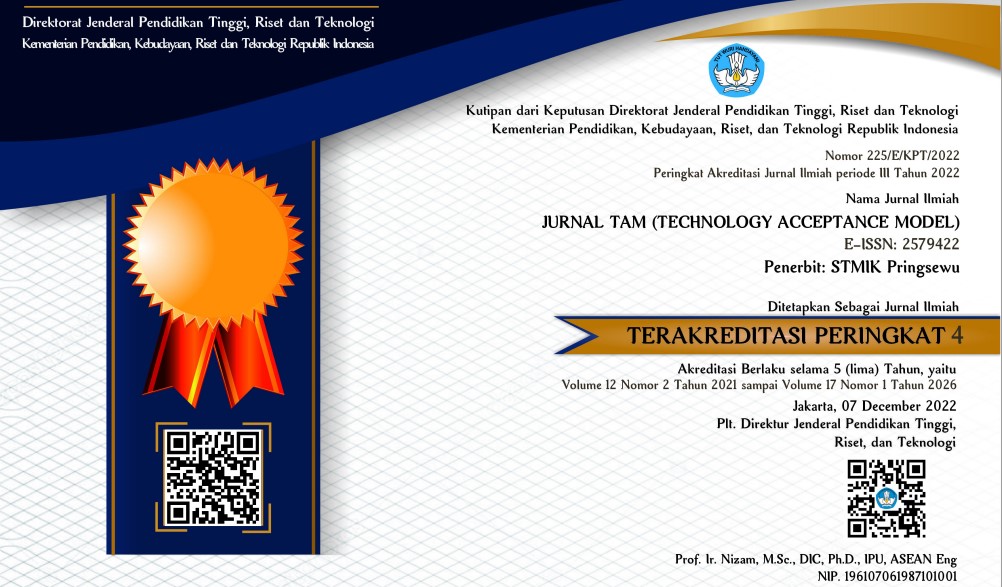ENTERPRISE ARCHITECTURE PLANNING AS A BLUE PRINT PROMOTION STRATEGY FOR MAHAN TAPIS' BUSINESS MANAGEMENT GROUP
(1) Study Program of Islamic Economics, STEBI Tanggamus, Lampung
(2) Study Program of Information Systems, FTIKOM, Bakti Nusantara Institute, Lampung
(3) Study Program of Information Systems, FTIKOM, Bakti Nusantara Institute, Lampung
 Corresponding Author
Corresponding Author
Abstract
The advances and technological developments that we enjoy today are the result of the era of globalization. The existence of technological advances in the business world is marked by the emergence and increase of Micro, Small, and Medium Enterprises (MSMEs). The problems that occur in the scope of business actors show that business actors in Pringsewu Regency still depend on simple customer-to-customer (C2C) business management. Research conducted by designing Enterprise Architecture Planning for this group of business actors is expected to be able to encourage business progress and business quality, such as changes in promotion strategies and sales transactions. Enterprise Architecture Planning (EAP) is a modern approach to planning data quality and achieving information system missions, including the steps taken to define the architecture for using information to support business and plan the implementation of that architecture. The results of the research are in the form of system architecture design, interface architecture design, and technology architecture design. The resulting architectural design allows for more open coordination between IT and business units, providing businesses with opportunities to prioritize investments and making it easy to test the current architecture against long-term goals.
Keywords
References
G. V. Setiadi, “Review : Perkembangan Ekonomi Digital di Indonesia,” 2019.
Y. Febriani, “Jurnal sistem informasi dan tenologi,” Sitech, vol. Vol 1, No, no. 1, hal. 1–6, 2018.
F. Tiyana dan A. D. Manuputty, “Perencanaan Strategis Sistem Informasi Dengan Metode Ward and Peppard Dalam Penjualan Di Home Industri,” IT-Explore J. Penerapan Teknol. Inf. dan Komun., vol. 1, no. 1, hal. 1–16, 2022.
M. Sari, “Analisis Strategi Pemasaran Dengan Menggunakan Metode Quantitative Strategic Planning Matrix (QSPM) Pada Usaha Kecil Menengah (UKM) (Studi Kasus pada Roman Indah Ukm di Padang),” J. Ilmu Manaj. Terap., vol. 1, no. 1, hal. 86–96, 2019.
M. Utami dan D. Sunardi, “Modeling Micro Business Mobile Commerce Architecture Using Eap And Togaf Adm Framework,” J. Inf. Technol. Comput. Sci., vol. 3, no. 2, hal. 290–297, 2020.
T. A. S. Musthofa dan G. Wang, “Perencanaan Sistem Informasi untuk Mendukung Analisis Pemasaran menggunakan Metode EAP pada PT. Cherokendo Benua Wisata,” Eng. Math. Comput. Sci. J., vol. 1, no. 1, hal. 1–9, 2019.
R. E. Pariama dan A. W. R. Emanuel, “Enterprise Arsitektur Planning ( EAP ) untuk Universitas Pattimura Menggunakan TOGAF ADM,” J. Tek. Inform. dan Sist. Inf., vol. 7, no. 2, hal. 277–288, 2020.
A. W. Nugroho, S. Setiyowati, dan A. Kusumaningrum, “Metode Enterprise Architecture Planning Untuk Merencanakan Sistem Informasi Manajemen Anggaran Perguruan Tinggi Swasta,” J. Ilm. SINUS, vol. 18, no. 2, hal. 43, 2020.
L. Bangsawan, J. Safitri, S. S. Mandala, dan R. Irvianif, “Information System of Marketing Management At Reymart Grocery Store Based on Enterprise Architecture Planning Method,” J. TAM (Technology Accept. Model., vol. 11, no. 2, hal. 125–149, 2020.
M. W. S. U, H. Risnanto, S. N. Rayani, dan M. Fahmi, “Analisis Strategi Bisnis Sistem Informasi Jasa Penyedia Perjalanan Wisata,” hal. 8–9, 2018.
Suliswiyadi, “Analisis SWOT Strategi Pengembangan Sekolah Unggul,” Tarbiyatuna, vol. 10, no. 1, hal. 21–31, 2019.
Article Metrics
Abstract View : 305 times
: 305 times Download : 200 times
Download : 200 times
DOI: 10.56327/jurnaltam.v14i1.1421
Refbacks
- There are currently no refbacks.





